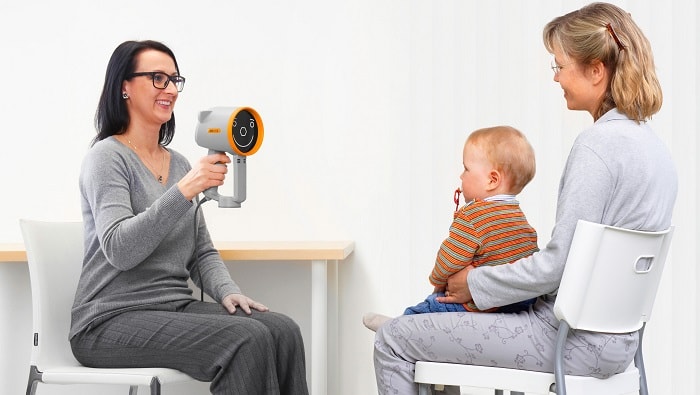Vision occurs in the brain, not the eye. Our eyes convert light into a signal that the brain makes sense of, but sight actually occurs in the brain.
During childhood, an eye defect – such as one eye being out of focus – results in an abnormal signal to the brain. The neurons connected to the abnormal eye will themselves develop abnormally. The result: vision loss and poor depth perception. This is called amblyopia.
Therefore, amblyopia is a brain problem that presents as decreased visual acuity and poor depth perception. Affecting 3% to 5% of all children, amblyopia becomes permanent unless it is detected and treated early in life. Amblyopia is the primary cause of unilateral vision loss1 and there is evidence that adults with amblyopia have reduced lifetime earnings, incur greater medical expenses, and are at increased risk of total blindness.2 Indeed, amblyopia is a disease with consequences.
There are three causes of amblyopia. First, the eyes may be misaligned. This is called strabismus and is usually obvious. Second, there may be occlusion of one eye, with something blocking the image from entering the eye. More common examples are cataract and ptosis (droopy eyelid). Again, these are commonly evident or seen easily with exam instruments in the pediatrician’s office.
The third cause of amblyopia is the most common and, unfortunately, the most difficult to detect. When one eye is out of focus, this is called anisometropia. A blurred image from one eye causes amblyopia just as surely as strabismus or a cataract will. The hard part: It is impossible to know whether anisometropia is present unless it is tested for.
Ideally, vision screening begins shortly after birth. Newborns should be evaluated for cataracts and the front of the eye examined with a penlight. See the sidebar for a recommended schedule for ocular and vision screening from the American Association for Pediatric Ophthalmology and Strabismus. The gold-standard exam is having the child read an eye chart. If the child can tell us what they see, then we know whether there is a problem.
Many 4-year-olds can cooperate with reading a chart, but some cannot. And what about younger children or those with intellectual and cognitive problems who will never read a chart? How can we determine whether they are at risk of developing or currently have amblyopia? For these populations instrument-based vision screening is effective and very useful. The American Academy of Pediatrics (AAP) issued a Policy Statement in 2012 addressing this3
Screening for amblyogenic refractive error with instrument-based screening is not dependent on behavioral responses of children, as when visual acuity is measured. Instrument-based screening is quick, requires minimal cooperation of the child, and is especially useful in the preverbal, preliterate, or developmentally delayed child. Children younger than 4 years can benefit from instrument-based screening, and visual acuity testing can be used reliably in older children.
Earlier detection results in better outcome at lower cost. For this reason, all science-based professional organizations (such as AAPOS, AAP, NEI, etc.) recommend early and frequent vision screenings beginning as early in life as possible.
“Photoscreening and handheld autorefraction may be electively performed in children 6 months to 3 years of age, allowing earlier detection of conditions that may lead to amblyopia, as well as in older children who are unable or unwilling to cooperate with routine acuity screening,” the AAP stated3
MANAGEMENT
Amblyopia can be reversed and even cured by forcing the brain to use the amblyopic eye. This involves temporarily making the “good eye” see worse than the amblyopic eye. Once the brain accepts images from both eyes equally well there is no further need for treatment. The most common methods of treating amblyopia are to A) put a patch over the “good eye” or B) to use an eye drop (atropine) that blurs the “good eye.” There are specific indications for these therapies but both essentially force the brain to use the amblyopic eye.
Treatment should start as early in life as possible. The earlier in life that amblyopia treatment begins, the earlier it will end and the less expensive it will be4. The brain is much more “plastic” when it is younger and most children respond very well until around 7 to 9 years. That said, recent evidence demonstrates treatment can still be very effective until 12 years and somewhat effective until 16 years.5
Reference
1. Multi-ethnic Pediatric Eye Disease Study Group. Prevalence of amblyopia and strabismus in African American and Hispanic children ages 6 to 72 months the multi-ethnic pediatric eye disease study. Ophthalmology. 2008;115(7):1229-1236.e1.
2. Hatt SR, Leske DA, Kirgis PA, et al. The effects of strabismus on quality of life in adults.
Am J Ophthalmol. 2007;144(5):643-647.
3. Miller JM, Lessin HR for the American Academy of Pediatrics Section on Ophthalmology. Instrument-based pediatric vision screening policy statement.
Pediatrics. 2012;130(5):983-986.
4. Membreno JH1, Brown MM, Brown GC, et al. A cost-utility analysis of therapy for amblyopia. Ophthalmology. 2002;109(12):2265-2271.
5. Holmes JM, Lazar EL, Melia BM. Effect of age on response to amblyopia treatment in children. Arch Ophthalmol. 2011;129(11):1451-1457.





















